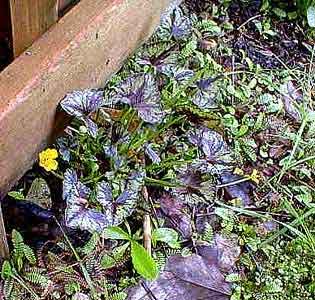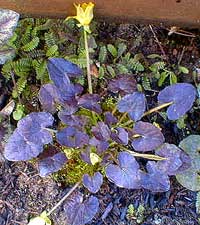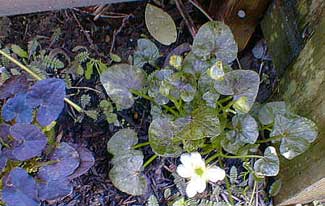
Lesser Celandine,
aka Pilewort,
or Smallwort
"There is a flower, the lesser celandine,
That shrinks like many more from cold & rain,
And the first moment that the sun may shine,
Bright as the sun himself, 'tis out again!"
-William Wordsworth
(1770-1850)
(1770-1850)
Lesser Celandine (Ranunculus ficaria) is unusually prone to sports & variants. The history of Ranunculus cultivars is rather startling, with unexpected ups & downs of popularity. According to Alice M. Coates' reconstruction in Flowers & Their Histories (1956), we find its rise & decline goes something like this: John Gerard writing in the late 1590s knew only one variety, a double dark red, while John Parkinson in 1633 knew but eight, whereas twenty were cataloged in the Royal Gardens in Paris in 1665. This slow start led to a veritable explosion of varieties, for near the end of the next century, in a 1792 plant catalog from James Maddock, there were a whopping 800 named cultivars!
 The decline of interest was just as shocking, since by 1820 there were half as many cultivars remaining in the trade (still a healthy 400), & this decline continued until in 1851 George Glenny declared it "a neglected flower" & by the end of the century Shirley Hibberd recorded how there to be only about 20 varieties offered in catalogs.
The decline of interest was just as shocking, since by 1820 there were half as many cultivars remaining in the trade (still a healthy 400), & this decline continued until in 1851 George Glenny declared it "a neglected flower" & by the end of the century Shirley Hibberd recorded how there to be only about 20 varieties offered in catalogs.Now here we are early in a new millenia, a time when there are specialty growers again introducing new varieties by the handsful. One European grower alone catalogued 119 varieties in 2003. Some of the named varieties are naturally occuring variants, with endless hybrid possibilities for each of these. Several have been preserved throughout the last century, but new ones are now being registered hand-over-fist. It may well be that the majority of the new varieties will in time fall by the wayside, as so many previous generations. But for the time being they are something of a fashion among European, American, & Japanese gardeners, & may be expected to be with us for a while.
We have three variants. One is deeply yellow-flowering, called "Dusky Maiden," shown in the first mid-March photograph at the top of this page. It has the most ornately mottled leaves in black & chocolate & bronze-green. The second variety is again the usual yellow flower, but with blue-black foliage, shown in the second photo, & it is called "Brazen Hussy."
The last, seen in the third photo, has off-white blooms & is called "Crawshay Cream." It originated as a cross between a natural pure white variant ("Albus") with normal green leaves, hybridized with the likewise naturally-occurring "Brazen Hussy," resulting in green & plum mottled leaves & cream colored bloom.
 The unusual & variegated foliages form the best features of our few specimens. In our zone, Coleus is a transient annual, & the variegated forms of Lesser Celandine can fill that vacant niche for colorful leaves. As these varieties cross-fertilize at will, & we've made no effort to segregate them, they will self-seed with unpredictable outcome, much as do fancy columbines. Deadheading would force them to spread by bulbils alone & preserve the selected varieties, but we're not attempting to control how they naturalize.
The unusual & variegated foliages form the best features of our few specimens. In our zone, Coleus is a transient annual, & the variegated forms of Lesser Celandine can fill that vacant niche for colorful leaves. As these varieties cross-fertilize at will, & we've made no effort to segregate them, they will self-seed with unpredictable outcome, much as do fancy columbines. Deadheading would force them to spread by bulbils alone & preserve the selected varieties, but we're not attempting to control how they naturalize.The flowers are very bright & nice but are outshined by the glossily colorful arrowhead foliage. The flowers open late in the morning, & close in the afternoon, being wide-open & friendly at midday. The leaves die back in June & don't reappear until late December or January, but their little area is not left empty in summer, as the rest of the year we have a very tiny but much-spreading groundcover called Brass Buttons (Cotula squalida) which fills the location, & only partially dies back in winter.
Due to their being potentially invasive, we placed them where it would not matter, but might even be rather nice, if they spread a great deal. Bulblets & especially the seeds take some while to mature to blooming capacity, & after two years there are still only the specimens where we planted them at the foot of the Akebia arbor. The roots produce bulbils or tubercles that are very small. If anyone changes their mind about having Ranunculus in a given spot, it could well be too late, as such wee bulbils will never be sieved back out of the soil.
This native of Europe, Northwest Africa & Southwest Asia will do well in full sun to partial shade. Ours being under an arbor get only indirect lighting & are in moist fertile soil. They blooms from March until May. Though the pretty leaves can clump up to four or five inches, ours are only ever three inches high, with an eight inch spread.
Ranunculus means "Little Frogs," for the plant grows in damp areas conducive to frog populations, & some frogs have markings similar to the leaf marblings of certain Ranunculous. The common name "Lesser Celandine" always seems inadequate, because it neither looks like nor is it related to Greater Celandine (Chelidonium majus) beyond sharing the yellow color of the flowers.
The genus name, first used by Pliny, has modernly become its preferred common name because Ranunculus sounds so much more pleasant than Pilewort. The homelier name came about because it was believed the plant was a cure for piles, which is to say hemorrhoids. The healing power was magical more than herbal, & according to Culpepper one need only wear pilewort anywhere upon the body to effect the cure. Saponins & tannin in the bulbils & leaves may or may not possess a sufficient astringent value to have some actual small benefit, but since efficacy is often strictly in the mind when it comes to the majority of herbal remedies, we find that "pilewart ointment" is still available from alternative medicine resources, & placebo effect is sufficient that many users are satisfied. Traditionally it was said that the leaves of Pilewort were the color of piles, for according to The Doctrine of Signatures, a plant had to in some manner bear the "signature" or appearance of its medicinal value. It is luck that its popularity did for so long survive the absurd slander.
Roots & bulbils were also used to treat the Plague in Elizabethan times, & in Pliny's day Pilewort was used as a cure for leprosy, to no avail however. Consumption & all manner of terrible diseases were thought to be cured by this plant, though beyond its mild astringent value it is not one of the more promising candidates for significant medicinal properties.
A tradition arose in Scotland based on the idea that a cluster of the oblong bulbils resembled a cow's udder in miniature, & this association was heightened by having flowers the color of butter. Dried bulbils were therefore hung in cattle byres with the expectation that this would cause the cows to produce more milk & butterfat.
It's usefulness went beyond the sundry folklores of magical properties. Though rarely eaten nowadays, it is in fact an edible plant. The leaves can be sauted in butter or cooked in any manner as a substitute for spinach, although it is too acrid to be palatable uncooked, as well as mildly toxic if eaten raw. Flower buds preserved in vinegar are a substitute for capers. The tiny bulbils, though hard to gather in sufficient numbers for a meal, are a good source of dietary starch, supplementing potatos.
In The Natural History of Plants by Anton Joseph Kerner Ritter von Marilaun (1831-1898), the recurring legend of "the rain of potatos" is explained as having arisen from the fact that Ranunculus bulbils are close to the surface & after a heavy rain can be exposed out of the ground, & can even ebeen washed down a hillside into irrigation channels. Kerner claimed these miniscule "potatoes" were washed into channels in such numbers that people could dip their hands into the water to obtain fists full at a sweep, cleaned by the water & ready to cook. I know of no modern authority who has substantiated this natural history, but it would be a credible enough survival feature permitting Ranunculus to disperse its bulbils after heavy spring rains, while to superstitious observers it would appear as a foodsource dropped by the clouds.